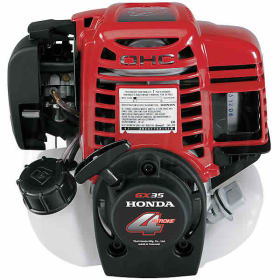Honda’s mini four strokes are designed to replace two stroke engines in applications ranging from string trimmers to tillers, which means they need to function in any position. To do this, they use a unique internal design that makes caring for them a little different from standard two and four stroke motors. Here’s what you need to know to maintain the GX25, GX35, GXH50 and GXV50 engines in this lineup.
Fuel
These engines can run off of straight automotive gasoline that has at least an 86 octane rating and contains a maximum of 10% ethanol or 5% methanol. Fuel freshness is important: gasoline should be used within one month of purchase, or within three months if it has been treated with a fuel stabilizer. Briefly running the engine on fuel mixed with two stroke oil shouldn’t damage it, but this fuel should be drained out as soon as possible. The tank and carburetor should also be drained before putting the engine in storage.
To remove fuel from the engine, make sure the oil cap is screwed in fully, then unscrew the fuel cap. Tip the engine so that the gas flows into a fuel container. Once empty, squeeze the priming bulb until all the gas has been drawn out of the carburetor.
Oil
Despite a unique oiling system that mists the oil through the entire motor no matter the position, checking and changing the oil isn’t much different from any other Honda engine.
To check the oil, the engine needs to be positioned so that the gas tank is below the motor. On vertical shaft GX22 and GX31 engines, this may involve tilting the equipment over. Remove the oil filler cap/dipstick, wipe it clean, then insert it back into the filler neck without screwing it in. The oil should come up to at least the bottom mark on the stick. Honda recommends checking the level before each use or every 10 hours of continuous use.
To change the oil, remove the dipstick and tilt the engine, letting the oil flow into a container for recycling. Doing this while the motor is still warm will help the oil pour out faster. Set the engine in the oil check position and add oil until it comes up to the edge of the filler neck. 10W30 oil is recommended, while 5W30 can be used if the motor will be operated at temperatures below 32°F (0°C.) The oil should be changed after the first 10 hours of use to remove contaminants from breaking it in. After that, replace the oil every 6 months or 50 hours of use.
When storing the engine at the end of the season, remove the spark plug and pour a teaspoon of oil into the plug hole. Pull the starter handle a few times to distribute the oil inside the cylinder, then reinstall the spark plug. When the motor is started again, it’s normal for the engine to smoke a little as this oil is burnt off.
Air Filter
Honda recommends checking the air filter for contaminants before each use and cleaning it every three months or 25 hours. On tillers, the air filter can be accessed by squeezing the tabs on the top and bottom of the cover and sliding the cover outward. On all other engines, simply push in the tabs at the top of the cover, then tilt the cover downward.
To clean the filter, remove it from the air box and either rinse it in water and a mild detergent or spray it down with a non-flammable solvent. Once the element is dry, soak it in clean engine oil and squeeze out any excess oil. Wipe out the air box before reinstalling the filter.
Spark Arrester
The spark arrester can collect carbon deposits that should be scrubbed off with a wire brush every 100 hours of use. Let the engine cool for at least 15 minutes before attempting this repair to avoid burns.
Depending on the motor design, there will either be a small cover over the muffler, or a cover that goes over the entire top of the engine. Large covers serve as a mounting point for the spark plug wire; the wire bracket will need to be unbolted before unbolting the cover itself.
Once the cover is off, the arrester can be removed from the exhaust opening by removing a single screw. When scrubbing off the deposits, inspect the spark arrester and replace it if it has holes or cracks.
Getting Parts for Your Mini Four Stroke
Hondalawnparts.com is a certified dealer for Honda Engine and Honda Power Equipment, so we have all the OEM parts you need to keep your motor in top condition. Our search engine lets you see where parts fit on factory diagrams, making it easy to order what you need. We can ship your order to any address in the U.S. and Canada.


